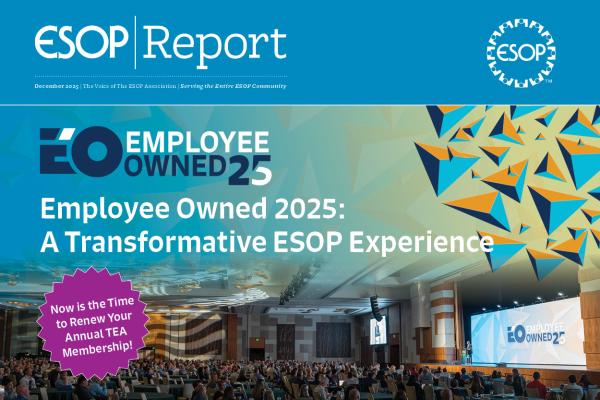Just over 50 years ago, the United States Congress passed the first law to encourage the introduction of Employee Stock Ownership Plans or ESOPs. As ESOPs proceed into the second half of their first century of practice, a promising new idea is under consideration that could help to both sustain and grow the ESOP marketplace to a new level of prominence. Introduced on a bi-partisan basis into the 119th Congress in May of 2025, the American Ownership and Resilience Act (AORA) would expand pools of investment capital necessary to grow the field while respecting the original intentions of the founders of ESOP legislation to create not ephemeral employee ownership but stable, long term employee ownership which broadens participation in business ownership and strengthens the American economy.
The Need and the Challenge
In today’s economy, business owners sympathetic to the idea of selling their businesses to their employees face a practical dilemma. Because employees do not have the resources to acquire firms they work for, business owners have been forced to help consummate the sale of their own firms through the use of “seller notes.” This practice of seller financing, most often undertaken in combination with conventional senior bank lending, has generally been positive. It is abundantly clear however that sellers facing a choice between full and efficient cash offers from deep-pocketed private equity and strategic buyers on the one hand and more complex internal sales that require sellers to maintain an at-risk relationship to the firm they are attempting to sell has put the ESOP alternative at a distinct disadvantage. The challenge this dilemma has long posed to the ESOP field has been how to secure institutional capital that can reduce or remove seller risk in order to create a level playing field for ESOP transactions to compete against the conventional private equity or strategic buyer alternatives.
AORA confronts this challenge by borrowing from a storied tradition of federal legislative initiatives that encourage private financial institutions to undertake worthwhile public policy goals not through the use of direct appropriations but instead through the practice of credit enhancement that reduces investor risk. Beginning with a desire to assist farmers in the 19th century and extending to first-time home owners and small business people and exporters in the 20th century, the strategy of enlisting the “full faith and credit” of the federal government through loan guarantees to reduce risk has provided successful incentives to private financial institutions to achieve outsized results for the American taxpayer.
AORA would extend this practice by providing federal loan guarantees to investment funds that would supply the missing high-risk capital to support both the creation and the recapitalization of existing majority ESOP owned companies. Access to this capital through loan guarantees will enhance the visibility and relevance of the ESOP alternative, enabling it to join in the list of more conventional mergers & acquisition techniques business owners learn about when they decide to sell.
How AORA Would Work
AORA would extend direct credit enhancement to both existing investment groups and newly created investment entities specializing in ESOP transactions. These investment funds would raise private investment capital from limited partners that would be matched on a 1:1 basis. With that private capital in hand, groups would apply to the United States Department of Commerce to receive an Ownership Investment Company (OIC) license. AORA would authorize $5 Billion-dollars of federal credit on an annual basis to apply to OIC funds. However, this would not be an appropriation—the program is required to operate at zero subsidy cost to the taxpayer. Qualified individual OIC funds could make use of up to $500M of low-cost debentures issued by the Commerce Department (matched dollar-fordollar with privately raised institutional capital) that they must deploy over a 10-year period.
OIC investments would focus upon growth capital in existing ESOPs as well as “de-novo” S Corporation ESOP transactions that result in majority ESOP owned firms. OIC funds would be subject to conventional investment risk. OIC funds will attract the investment community due to the existence of a low-cost leverage that enhances their returns. AORA enabled ESOP transactions will be structured on a majority employee ownership basis. Most transactions are likely to take full advantage of tax favored S Corporation ESOP status as 100% ESOP companies. OIC funds will receive their returns from ESOP companies through a combination of debt, synthetic equity, or preferred equity. The “spread” between the credit enhanced cash received by OIC funds and the rate at which those funds are deployed will generate the return for their investors while also allowing the timely repayment of debentures to the federal government.
As has been the case for a range of federal credit enhancement initiatives administered over decades by the Department of Agriculture, the Federal Housing Administration and the U.S. Export-Import Bank, the launching of AORA authorized Ownership Investment Companies overseen by the Department of Commerce will not appreciably contribute to the federal deficit or bureaucratic apparatus. The expected positive return of principal and interest on debentures issued by Department of Commerce for OIC’s “pays for” the OIC program and is designed to make money for the federal government. Credit enhancement programs such as these also make use of the expertise of qualified professionals operating in the private market. Private OIC fund managers will be in a “first-loss” position in administering their funds and will therefore be incentivized to make prudent investments. The government would not be in the position of picking winners and losers.
The arrival through AORA of much needed capital to grow the ESOP market should not sacrifice fiduciary and corporate governance protections that established ESOP regulations provide. AORA has been drafted to include those standards and to insist upon best practices including requirements for independent trustees and fairness, event protection for participants, and strict prohibitions on employees paying out of pocket for shares either directly or through retirement plan rollovers.
Conclusion
Should AORA be adopted by Congress, an entirely new dimension of capital provider will be added to the ESOP marketplace. The arrival of the Taxpayer Relief Act of 1997 enabling S Corporation ESOP structures to own 100% of company stock introduced the idea of ESOPs as full-fledged control buyers of firms. That development moved the ESOP field closer to the ranks of conventional mergers and acquisition (M&A) practices but also starkly exposed the limitations of financing options that could grow the ESOP idea. Seller financing has proven functional but not attractive to the wide marketplace of business owners wishing to efficiently sell their firms with a minimum of personal risk. As a result, ESOP growth has stagnated.
AORA promises to open the ESOP field to a broader and deeper pool of capital sources that can supplement the seller financing option. ESOPs will be able to move from their existing status as a not well known “sell-side” option initiated by sellers and their advisors who have become aware of the ESOP alternative to that of a “buy-side” option on the part of well capitalized and entrepreneurial funds motivated to seek out and engineer efficient corporate transactions that enable every employee to own a stake in the businesses in which they work.
Because of the credit enhancement feature that reduces their risk, fund managers and investors can be expected to be drawn to this novel approach to the mergers and acquisitions market. Business owners inclined to prefer an internal ESOP sale in order to reward the employees who helped them succeed can expect offers from OIC funds that are fully price competitive and equally efficient to private equity or strategic buyers.








